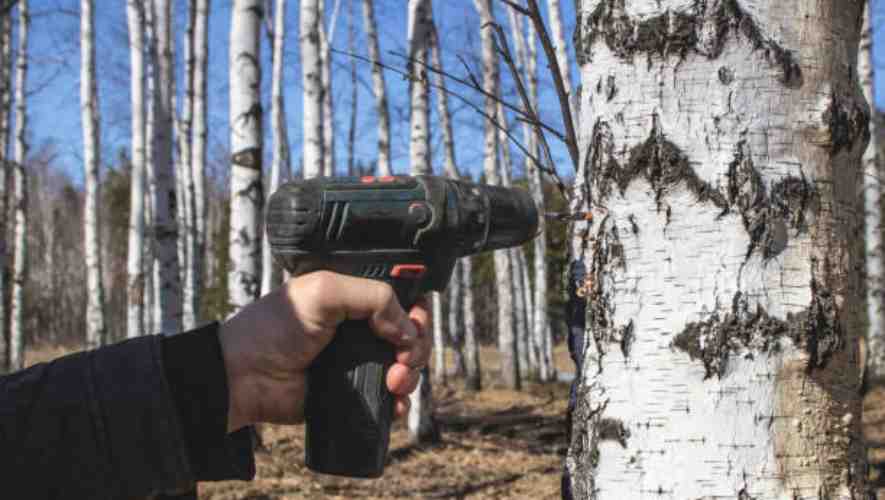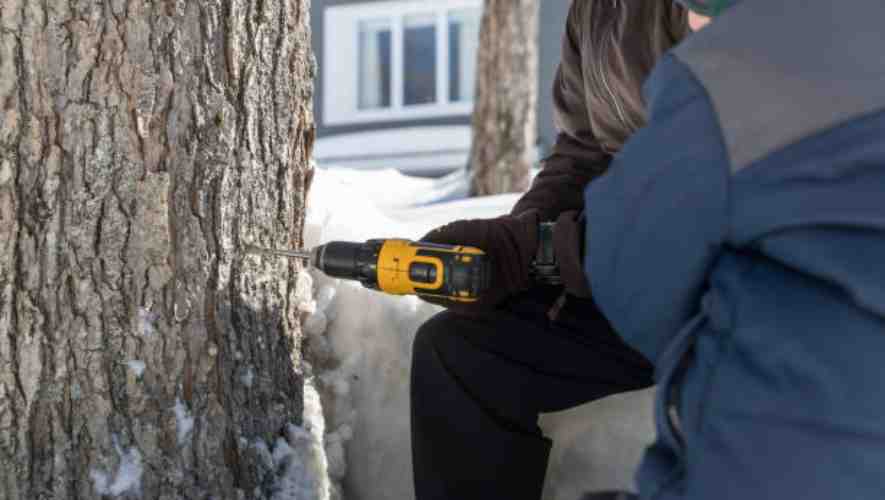When the maple syrup season approaches, many enthusiasts and professionals alike begin to think about tapping maple trees. This process involves drilling into the maple tree to insert a spout or ‘tap’ from which the sap flows. The size of the drill bit used in this operation is critical, as it affects the health of the tree and the efficiency of sap extraction.
What Size Drill Bit For Maple Taps? The ideal drill bit size for maple taps is 5/16 inches. This size ensures optimal sap flow while minimizing tree damage. Smaller bits may not accommodate standard taps, while larger ones can harm the tree.
If you’re planning to tap maple trees for syrup, you’re in the right place. This guide will delve into the specifics of choosing the right drill bit for maple tapping, providing insights into techniques, tree health considerations, and tools. By the end of this article, you’ll be equipped with the knowledge to efficiently and sustainably tap maple trees, ensuring a rewarding syrup harvest.
Understanding Maple Tapping

Maple tapping is a traditional and sustainable method used to extract sap from maple trees. This process, deeply rooted in North American history, primarily targets sugar maple trees. The sap, a clear liquid, is harvested by drilling small holes into the tree’s trunk and inserting a spout.
This technique relies on the natural flow of sap within the tree, which is influenced by environmental conditions. Maple tapping is significant as the sap is the primary source for producing maple syrup, a natural sweetener cherished worldwide for its unique flavor.
The primary purpose of maple tapping is to collect the sap used to produce maple syrup. This practice has both cultural and economic importance. Culturally, it connects communities to a longstanding tradition,in regions like the Northeastern United States and Canada.
Economically, maple syrup production is a vital industry, supporting local economies and small-scale farmers. The process also serves an educational role, teaching about ecology, tree biology, and sustainable agricultural practices.
Maple tapping is highly dependent on specific seasonal conditions and occurs in late winter to early spring. This seasonality is crucial because the sap flow is driven by the freeze-thaw cycle.
During this period, night-time temperatures drop below freezing, and daytime temperatures rise above freezing. This temperature fluctuation creates pressure within the tree, allowing the sap to flow more freely when tapped. The exact timing of the season varies by geographic location and yearly climatic conditions.
Step-by-Step Guide to Drilling

Introduction to Maple Tree Drilling
Drilling into a maple tree requires precision and understanding of the tree’s biology to avoid harm. This guide is designed to help both beginners and experienced individuals in safely drilling into maple trees.
The process involves selecting the right tools, understanding the best time for drilling, and being aware of the tree’s health. Drilling at the wrong time or incorrectly can cause irreversible damage to the tree. Our guide ensures you get the sap without harming the tree.
Choosing the Right Tools
Selecting appropriate tools is crucial for efficient drilling. You’ll need a drill, a drill bit specifically designed for maple tapping, and spiles (spouts). The ideal drill bit size is 5/16 inches, as it creates a hole large enough for sap flow but small enough for the tree to heal.
Ensure your tools are clean and sharp for precise cutting. Using dull or dirty tools can damage the tree and impede sap flow.
Timing and Tree Selection
The best time to drill into a maple tree is late winter to early spring. This is when the sap starts flowing, just before the tree buds. The temperature should ideally fluctuate between below freezing at night and above freezing during the day.
Choose a mature tree, at least 12 inches in diameter. Young or unhealthy trees may not withstand the stress of tapping and can be severely damaged.
Drilling Technique and Depth
Drill at a slight upward angle to facilitate sap flow out of the tree. The hole should be about 2 to 2.5 inches deep, enough to penetrate the bark and access the sapwood where the sap flows. Start drilling slowly and increase speed once the bit has gripped the tree.
Keep the pressure steady and avoid pushing too hard, as this can damage the tree’s internal structure.
Aftercare and Sustainability
Once you have finished tapping, it’s important to care for the tree. Do not plug the hole; the tree will naturally heal itself. Monitor the health of the tree and avoid tapping the same tree in consecutive years if possible.
Sustainable tapping ensures the long-term health of the maple tree and a continuous supply of sap. Always consider the tree’s health as a top priority in your drilling process.
Tools Required for Maple Tapping

Introduction to Maple Tapping
Maple tapping is a centuries-old practice used to extract sap from maple trees, which is then processed into maple syrup. This method requires specific tools and techniques to ensure efficient and sustainable sap extraction.
The quality of these tools, the drill and drill bits, plays a crucial role in the tapping process. Understanding the essential tools and their functions can significantly enhance the tapping experience and the quality of the syrup produced.
Essential Tools for Maple Tapping
The process of maple tapping requires a set of specialized tools to effectively extract sap without harming the maple trees. These tools include a drill for creating tap holes, drill bits, splices or taps, a hammer, sap buckets or tubing systems, and a collection container.
Each tool has a specific role, from piercing the tree bark to collecting the sap. Proper usage of these tools ensures a successful sap harvest and the long-term health of the maple trees.
The Drill: A Key Tool in Maple Tapping
The drill is a fundamental tool in the maple tapping process, used for creating precise holes in the tree trunk. These holes are essential for inserting the spiles that allow sap to flow out of the tree.
An ideal drill should be lightweight, easy to handle, and powerful enough to penetrate the tree bark smoothly. The efficiency of the drill directly impacts the ease of the tapping process and the amount of sap collected.
Importance of Drill Bit Quality and Size
Drill bits are critical in maple tapping, as they determine the size and quality of the tap holes. The right drill bit size ensures minimal damage to the tree and optimal sap flow. A 5/16-inch or 7/16-inch drill bit is used.
High-quality drill bits are sharp, durable, and resistant to wear, allowing for clean and efficient drilling. Using the correct drill bit size and maintaining its quality are essential for sustainable tapping practices.
Choosing the Right Drill Bit Size

Importance of Accurate Drill Bit Size
The size of the drill bit is paramount in maple tapping as it directly affects the health of the tree and the yield of sap. An appropriately sized bit ensures minimal damage to the tree, facilitating quicker healing. This precision helps maintain the tree’s longevity and productivity, crucial for sustainable maple syrup production.
Recommended Drill Bit Sizes
For optimal results in maple tapping, specific drill bit sizes are recommended. A 7/16 inch bit is ideal for most maple trees. However, in cases where tree health or diameter is a concern, a smaller 5/16 inch bit can be used. These sizes balance efficient sap extraction with minimal harm to the tree.
Consequences of Oversized Drill Bits
Using a drill bit that is too large can be detrimental. It creates a larger wound in the tree, leading to excessive sap loss and a greater risk of infection. This not only reduces the tree’s sap yield in the current season but can also compromise its overall health and future productivity.
Risks of Undersized Drill Bits
Conversely, using a bit that is too small can also have negative consequences. It may lead to insufficient sap flow, reducing syrup production. An undersized hole can close up too quickly, shortening the tapping season and potentially stressing the tree as it attempts to heal prematurely.
Balancing Size for Optimal Tapping
In summary, choosing the right drill bit size for maple tapping is a delicate balance. The goal is to maximize sap extraction while minimizing harm to the tree. Adhering to the recommended sizes ensures a sustainable approach to syrup production, benefiting both the trees and the producers.
Common Mistakes to Avoid in Maple Tapping

Maple tapping is a rewarding activity that allows you to harvest the sweet sap of maple trees, but it requires precision and care. To ensure a successful tapping season, it’s crucial to be aware of common mistakes and adopt best practices.
Below, we’ll explore frequent errors made during maple tapping and provide solutions and best practices to avoid these pitfalls.
Incorrect Timing
Mistake
Tapping the trees either too early or too late in the season can lead to reduced sap flow.
Solution
Monitor weather patterns closely. The ideal time for tapping is when the daytime temperatures rise above freezing, and nighttime temperatures fall below. This temperature fluctuation is key for optimal sap flow.
Inappropriate Tapping Locations
Mistake
Tapping in the wrong spot on the tree can harm the tree and yield less sap.
Solution
Choose a spot on the south side of the tree, where the sun hits directly. Ensure the spot is at least 2 to 4 feet above the ground and away from any old tap holes or visible scars.
Over Tapping Trees
Mistake
Inserting too many taps in a single tree can stress and damage the tree.
Solution
Follow the guideline of one tap for trees between 10 to 20 inches in diameter, two taps for trees 20 to 25 inches, and a maximum of three taps for trees over 25 inches in diameter.
Using Incorrect Equipment
Mistake
Utilizing old or unsanitary equipment can contaminate the sap and damage the tree.
Solution
Always use clean, sanitized equipment. Opt for spiles and buckets specifically designed for maple tapping, ensuring they are free from rust, dirt, and any residual sap from previous seasons.
Neglecting Immediate Processing
Mistake
Allowing sap to sit for too long before processing can lead to spoilage.
Solution
Process sap as soon as possible after collection. If immediate boiling isn’t feasible, store the sap in a cool, shaded area and ensure it’s processed within a few days of collection to maintain quality and prevent spoilage.
Conclusion
In conclusion, using a 5/16-inch drill bit for maple tapping strikes the perfect balance between maximizing sap yield and minimizing tree damage.
After exploring the intricacies of maple tapping, it’s clear that the right tools and techniques are essential for a successful sap harvest. While the 5/16-inch drill bit is ideal for most situations, always consider the health and size of the tree when tapping. Embracing this sustainable approach ensures that the trees remain healthy for future seasons, securing an ongoing supply of delicious maple syrup. Remember, the art of maple tapping is as much about respecting and understanding nature as it is about the sweet rewards. So, grab your drill, choose the right bit, and embark on the gratifying journey of maple syrup production.

